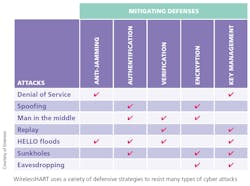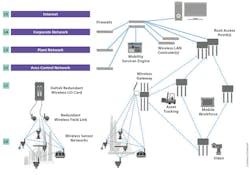Pharmaceutical manufacturing plants, both full-scale production facilities and laboratories, are generally networked using IT platforms such as Ethernet and Wi-Fi. These are essentially office networks that have been extended into manufacturing environments to serve a variety of functions, but were not designed with manufacturing support as their primary purpose.
In contrast, HART and WirelessHART were designed for process manufacturing applications, and are thus better networking protocols for instrumentation and device-level communication. Both networks are supported by the independent FieldComm Group, with hundreds of member companies.
Manufacturers considering ways to improve communication and process data capture within production units of every type and scale should consider adding WirelessHART for a variety of reasons.
Networking Flexibility
Like the manufacturing systems they support, networks have to be flexible. While the pharmaceutical industry is known for being very static due to regulatory constraints, things change more than many realize. But wired networks, while highly reliable, are not easy to change or expand. Adding coverage for new equipment, moving equipment in a new location, or enlarging a building requires pulling wires, which is very expensive. This becomes increasingly important when setting an Industrial Internet of Things (IIoT) strategy to improve the overall safety, reliability, and energy use at a plant. Adding wired infrastructure is often a large cost barrier when examining the feasibility of an extended monitoring program, not to mention the challenges with cleanability of power and signal cabling.
Why Use WirelessHART?
To describe why a pharmaceutical manufacturer would want to use WirelessHART, we should first describe what it is. WirelessHART, also known as IEC 62591, is a self-organizing mesh network consisting of individual field instruments and a gateway. The wireless field devices, containing power modules, communicate with each other, while the gateway provides a hardwired connection to the automation host system and/or asset management, monitoring or data analytics environment
Data from the field devices move to the gateway, which is normally connected to a larger network infrastructure. The data can be sent anywhere, securely — ranging from an individual production unit’s host system all the way to a secure cloud environment.
Where to use WirelessHART
The benefits of wireless instrumentation and a supporting network can be realized in three key areas within pharmaceutical manufacturing facilities:
- Process instruments and actuators for permanent production units
- Equipment diagnostic and condition monitoring sensors scattered throughout facilities
- Moveable and reconfigurable equipment used in lab and pilot-plant environments.
These three areas are distinct, so let’s look at each individually, and consider how wireless devices can be used and how the networks interact.
Process instruments for permanent production units
Wireless process instrumentation is the most common application in the majority of process manufacturing environments. Pharmaceutical production units tend to be straightforward, centering on single or multiple reactor trains. Many typical process instruments (flow, level, temperature, pressure, etc.) are available as native WirelessHART devices with an internal power module and permanently mounted antenna, but few are available with a hygienic design suited for product contact in pharmaceutical applications. Nonetheless, any hygienic wired device using 4-20 mA with HART can be outfitted with an external WirelessHART adapter so it can communicate on the wireless network.
There are also instruments designed to mount without touching the process directly, so they do not need a specific hygienic configuration. For example, a transmitter with Emerson’s Rosemount X-well technology can be mounted on the outside of a pipe and take a temperature reading without penetrating the process. It communicates via WirelessHART, so it can be placed anywhere within the coverage of the network.
The data from a WirelessHART instrument — a temperature sensor measuring the contents of a reactor for example — can then be sent to the host system controlling that unit. This can be seamlessly achieved by connecting the gateway, via a wired Ethernet or Modbus connection, to the host system.
This provides a great deal of flexibility as the decision to add or move an instrument does not require moving wires and reconfiguration. Additionally, when a control system is at its maximum I/O count, bringing an additional instrument or several via the Ethernet connection avoids having to add more I/O channels, if such is even possible.
Scattered diagnostic and condition monitoring sensors
Many pharmaceutical manufacturing facilities are deploying wireless instrumentation designed to monitor various types of in-plant systems and utilities to control costs, boost performance and improve efficiency. A wide variety of devices can be used to monitor steam traps, check the various elements of pumps, measure processed water usage and the like. These monitoring devices can operate on the same networks as the WirelessHART process instruments, reporting their data through the gateway and on to the larger plant networks.
Unless the equipment being monitored is critical to a specific process unit, this information normally exists outside of the process automation host systems and is handled by other departments, primarily maintenance or reliability. Since data needs collection and analysis to become useful information, these monitoring devices often require supporting analytic software to report performance data or provide alerts calling out areas needing attention.
Historically, creating these kinds of asset management systems was a major undertaking. But implementation is simpler now, using apps designed along the same lines as those on smartphones. These low-overhead software programs are easy to set up using pre-configured algorithms and dashboards.
Reconfigurable equipment used in lab and pilot-plants
Laboratory and pilot-plant environments have been quick to recognize the value of WirelessHART networks and their ability to provide an exceptionally high degree of flexibility. In these areas where equipment is small, moveable and reconfigurable — wired networks are difficult to use without frequent extensions, modifications, and adding or moving wires. Reactors, freezers and other equipment that may be rolled on wheels from area to area to serve various projects can require frequent reconfiguration, which is difficult when wired connections must be reestablished in a different area.
For example, a freezer used as part of a test batch will normally need continuous monitoring of its temperature for however many days or weeks it is used for a given project. It may be moved from one part of a facility to another for different projects and different users, but this is not a problem when it is reporting its data via a WirelessHART network.The same applies to a small laboratory reactor or portable clean-in-place (CIP) skid, each of which can be outfitted with a cluster of WirelessHART instruments to monitor and report its functions, regardless of its location within the facility.
[javascriptSnippet]
An acoustic monitor can listen to the sound of a steam trap and verify that it is functioning correctly. It can send its data to a condition monitoring app to indicate which traps might be malfunctioning and wasting energy.
Gateways and Network Density
As mentioned earlier, a WirelessHART network is a self-organizing, mesh network. This means the individual devices work together to ensure data from every device can reach the gateway. If a temperature sensor is unable to access the gateway directly, it will pass its information to another nearby device which has a better connection. The self-organizing capability allows this to happen automatically, with the network finding the best communication path without the need for operator intervention.
Network density is a factor since the more devices there are in a network, the more potential paths there are to the gateway. Still, in real-world environments, light-density networks spread over large spaces can be very successful, even when considering obstructions such as walls and floors.
Network design and monitoring tools are available to analyze network traffic, showing exactly how the individual devices are talking to each other. Weak communication links can be identified and helped by something as simple as better antenna placement or adding a wireless repeater (a transmitter to relay signals while generating no data of its own) to reinforce communication in a particular area.
Initial network design can determine the best locations for gateways and the optimal number of gateways for effective network management. While a single gateway can support up to 100 field devices, most users split large numbers of devices into smaller networks, generally segregated by units. For example, process instruments may be tied to one network, while asset monitoring devices are assigned to another. To handle these types of configurations, smaller capacity and less expensive gateways are available with support for up to 25 field devices.
Network management tools and the flexibility they provide are one of the major advantages of WirelessHART networks. Once gateways are physically placed and added, everything is configured via software. WirelessHART uses sophisticated security mechanisms to resist intrusions while ensuring reliability that can equal or even exceed wired systems.
Building IIoT Infrastructure
One of the characteristics of the IIoT is its ability to reach the very edges of industrial networks. While implementing IIoT concepts does not require wireless device-level networks, they make the task far easier than traditional wired topologies. Sending data from WirelessHART devices to the gateway and on to the plant network allows for easy access to each of those devices.
WirelessHART networks also make it easy to deploy new analytical tools such as pre-configured dashboards and condition-based maintenance programs. IIoT depends on data granularity, and these networks make it possible and practical to connect with individual field instruments, delivering the required level of detail.
This ability is changing manufacturing on all fronts, and it can have a profound impact on pharmaceutical producers. The IIoT facilitates data collection, analysis and movement more quickly than any mechanism to date. The ability to reach the cloud is very easy, supporting data access from anywhere.
The three use cases mentioned earlier for the pharmaceutical industry provide compelling reasons to explore this new approach, and it begins for many companies with WirelessHART field device networks.










